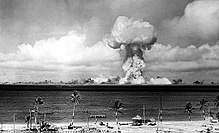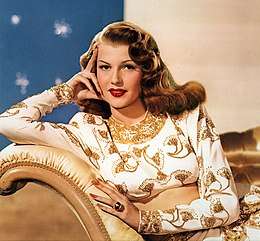Gilda
Gilda is a 1946 American film noir directed by Charles Vidor and starring Rita Hayworth in her signature role and Glenn Ford as a young thug. The film is known for cinematographer Rudolph Maté's lush photography, costume designer Jean Louis's wardrobe for Hayworth (particularly for the dance numbers), and choreographer Jack Cole's staging of "Put the Blame on Mame" and "Amado Mio", sung by Anita Ellis. In 2013, the film was selected for preservation in the United States National Film Registry by the Library of Congress as being "culturally, historically or aesthetically significant".[2] [3] [4]
| Gilda | |
|---|---|
.jpg) Theatrical release poster, "Style B" | |
| Directed by | Charles Vidor |
| Produced by | Virginia Van Upp |
| Screenplay by |
|
| Story by | E.A. Ellington |
| Starring | |
| Music by | M. W. Stoloff Marlin Skiles |
| Cinematography | Rudolph Maté |
| Edited by | Charles Nelson |
| Distributed by | Columbia Pictures |
Release date |
|
Running time | 110 minutes |
| Country | United States |
| Language | English |
| Box office | $3,750,000 (US rentals)[1] |
Plot
Johnny Farrell (Glenn Ford), a small-time American gambler newly arrived in Buenos Aires, Argentina, wins a lot of money cheating at craps. He is rescued from a robbery attempt by a complete stranger, Ballin Mundson (George Macready). Mundson tells him about an illegal high-class casino, but warns him not to practice his cheating skills there. Farrell ignores his advice, cheats at blackjack, and is taken by two men to see the casino's owner, who turns out to be Mundson. Farrell talks Mundson into hiring him and soon becomes the casino's manager.
Mundson returns from a trip and announces he has a new wife, Gilda (Rita Hayworth), whom he has married after only knowing her for a day. Johnny and Gilda instantly recognize each other, though both deny it when Mundson questions them. Mundson assigns Farrell to watch over Gilda. Johnny and Gilda are consumed with hatred for each other, and she cavorts with men at all hours in increasingly more blatant efforts to enrage Johnny, and in return he grows more abusive and spiteful towards her.
Mundson is visited by two German mobsters (Ludwig Donath and Lionel Royce). Their organization financed a tungsten cartel, with everything put in Mundson's name in order to hide their connection to it. They have decided that it is safe to take over the cartel now that World War II has ended, but Mundson refuses to transfer ownership. The Argentinian police are suspicious of the Germans and assign agent Obregon (Joseph Calleia) to try and obtain information from Farrell, but he knows nothing about this aspect of Mundson's operations. The Germans return to the casino during a carnival celebration, and Mundson ends up killing one of them.
Farrell rushes to take Gilda to safety and alone in Mundson's house, they have another confrontation and after declaring their undying hatred for each other, passionately kiss. After hearing the front door slam, they realise Mundson has overheard and a guilt-ridden Farrell pursues him to a waiting private airplane. The plane explodes in midair and plummets into the ocean; Farrell concludes that Mundson has committed suicide.
Gilda inherits his estate. Farrell and she immediately marry, but unknown to her, Johnny is marrying her to punish her for her betrayal of Mundson. He abandons her, but has her followed day and night by his men to torment her. Gilda tries to escape the tortured marriage a number of times, but Farrell, now rich and powerful, thwarts every attempt.
Obregon confiscates the casino and informs Farrell that Gilda was never truly unfaithful to Mundson or to him, prompting Farrell to try to reconcile with her. At that moment, Mundson reappears, revealing he faked his suicide. He tries to kill both Gilda and Farrell, but bartender Uncle Pio (Steven Geray) fatally stabs him. When Obregon arrives, Johnny tries to take the blame for the murder, but Obregon points out that Mundson was already declared legally dead and declines to arrest him. Farrell gives Obregon incriminating documents from Mundson's safe. Farrell and Gilda reconcile.
- Johnny Farrell (Glenn Ford) and Gilda (Rita Hayworth)
- "Gilda, are you decent?"
Cast
- Rita Hayworth as Gilda Mundson Farrell
- Glenn Ford as Johnny Farrell / Narrator
- George Macready as Ballin Mundson
- Joseph Calleia as Det. Maurice Obregon
- Steven Geray as Uncle Pio
- Joe Sawyer as Casey
- Gerald Mohr as Capt. Delgado
- Mark Roberts as Gabe Evans
- Ludwig Donath as German
- Don Douglas as Thomas Langford
- Lionel Royce as German
- George J. Lewis as Huerta
Cast notes
- Anita Ellis dubbed the singing voice of Rita Hayworth in all songs except the acoustic guitar version of "Put the Blame on Mame", which Hayworth sang herself.[6]
Production
Gilda was filmed from September 4 to December 10, 1945.[6]
Hayworth's introductory scene was shot twice. While the action of her popping her head into the frame and the subsequent dialogue remains the same, she is dressed in different costumes—in a striped blouse and dark skirt in one film print, and the more famous off-the-shoulder dressing gown in the other.
Critical response
When first released, the staff at Variety magazine liked the film and wrote, "Hayworth is photographed most beguilingly. The producers have created nothing subtle in the projection of her s.a. [sex appeal], and that's probably been wise. Glenn Ford is the vis-a-vis, in his first picture part in several years ... Gilda is obviously an expensive production—and shows it. The direction is static, but that's more the fault of the writers."[7]
Gilda screened in competition at the 1946 Cannes Film Festival, the first time the festival was held.[8]
More recently, Emanuel Levy wrote a positive review: "Featuring Rita Hayworth in her best-known performance, Gilda, released just after the end of WWII, draws much of its peculiar power from its mixture of genres and the way its characters interact with each other ... Gilda was a cross between a hardcore noir adventure of the 1940s and the cycle of 'women's pictures.' Imbued with a modern perspective, the film is quite remarkable in the way it deals with sexual issues."[9]
The review aggregator Rotten Tomatoes reported that 96% of critics gave the film a positive review, based on 25 reviews.[10]
Operation Crossroads nuclear test

While Gilda was in release, it was widely reported that an atomic bomb to be tested at Bikini Atoll in the Pacific Ocean's Marshall Islands would bear an image of Hayworth, a reference to her bombshell status. The fourth atomic bomb ever to be detonated was decorated with a photograph of Hayworth cut from the June 1946 issue of Esquire magazine. Above it was stenciled the device's nickname, "Gilda", in two-inch black letters.[11] Although the gesture was meant as a compliment, Hayworth was deeply offended.[12][13]:129–130
Memorabilia
The two-piece costume worn by Hayworth in the "Amado Mio" nightclub sequence was offered as part of the "TCM Presents ... There's No Place Like Hollywood" auction November 24, 2014, at Bonhams in New York.[14] It was estimated that the costume would fetch between $40,000 and $60,000; in the event it sold for $161,000.[15]

Home media
In January 2016 The Criterion Collection released DVD and Blu-ray Disc versions of Gilda, featuring a new 2K digital film restoration, with uncompressed monaural soundtrack on the Blu-ray version.[16]
References
- "60 Top Grossers of 1946", Variety 8 January 1947 p.8
- O'Sullivan, Michael (December 18, 2013). "Library of Congress announces 2013 National Film Registry selections". The Washington Post. Retrieved June 8, 2020.
- "Complete National Film Registry Listing | Film Registry | National Film Preservation Board | Programs at the Library of Congress | Library of Congress". Library of Congress, Washington, D.C. 20540 USA. Retrieved June 22, 2020.
- "Cinema with the Right Stuff Marks 2013 National Film Registry". Library of Congress, Washington, D.C. 20540 USA. Retrieved June 22, 2020.
- Truhler, Kimberly (October 17, 2014). "Style Essentials—Femme Fatale Rita Hayworth Puts the Blame in 1946's Gilda". GlamAmor. Retrieved June 2, 2017.
- "Gilda". AFI Catalog of Feature Films. Retrieved April 16, 2020.
- "Film Review: Gilda". Variety. December 31, 1945. Retrieved June 8, 2020.
- "Official Selection 1946". Festival de Cannes. Archived from the original on April 16, 2015. Retrieved February 3, 2016.
- Levy, Emanuel. Film review, 2009. Last accessed: February 9, 2010.
- Gilda at Rotten Tomatoes. Last accessed: February 9, 2010.
- "Atomic Goddess Revisited: Rita Hayworth's Bomb Image Found". CONELRAD Adjacent (blog). August 13, 2013. Retrieved March 11, 2015.
- Krebs, Albin (May 16, 1987). "Rita Hayworth, Movie Legend, Dies". The New York Times. Retrieved March 11, 2015.
- Leaming, Barbara (1989). If This Was Happiness: A Biography of Rita Hayworth. New York: Viking. ISBN 0-670-81978-6.
- "TCM Presents ... There's No Place Like Hollywood" (PDF). Bonhams, sale 22196, lot 244, catalog for auction November 24, 2014. Retrieved November 25, 2014.
- "Print Results, TCM Presents ... There's No Place Like Hollywood". Bonhams, sale 22196, lot 244, November 24, 2014. Retrieved November 25, 2014.
- "Gilda". The Criterion Collection. Retrieved October 18, 2015.
External links
- Gilda—essay by Kimberly Truhler on the National Film Registry website
- Gilda at the American Film Institute Catalog
- Gilda on IMDb
- Gilda at aenigma
- Gilda at the TCM Movie Database
- Gilda at AllMovie
- Gilda at Rotten Tomatoes
- Photos of Rita Hayworth in Gilda by Ned Scott
- "The Long Shadow of Gilda"—An essay by Sheila O’Malley at the Criterion Collection